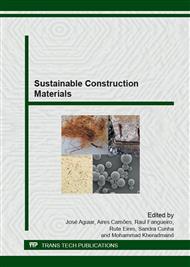p.455
p.467
p.473
p.479
p.485
p.498
p.506
p.517
p.527
Characterization of Parameters to Predict the Structural Behaviour of Geopolymeric Mortar Plates Strengthened with Carbon Fiber Reinforced Polymer
Abstract:
This study includes the identification of parameters for the characterization of the structural behavior of thin plates composed of geopolymer mortars structured with bi-directional carbon fiber mesh. Initially, facade projects, designed by offices in São Paulo using the concepts of sustainable architecture, promoting the use of geopolymeric materials are presented. Then shows the composition of the geopolymer mortar used in this study and the characterization of their mechanical properties. As part of the experimental program, this study evaluates the plate bending behavior and the effect of pull-out test and push-off test of the metallic inserts. It has used the advanced features of ATENA computational mechanics program, which correspond to the state of the art in Finite Element Modeling of reinforced concrete structures, which allow the calibration of the mathematical model based on information from the experimental program. The numerical results showed satisfactory adhesion with the experimental results. It also has emphasized the importance of validation of these results on the determination of loads collapse of structural elements, as is reflected positively in the field of Structural Engineering in the face of increasing advancement of surface modeling programs and technological innovations in according to sustainability criteria for constructions materials.
Info:
Periodical:
Pages:
485-497
Citation:
Online since:
December 2014
Authors:
Price:
Сopyright:
© 2015 Trans Tech Publications Ltd. All Rights Reserved
Share:
Citation:


